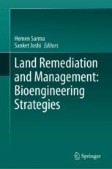Search
Search Results
-
Biomaterials for Sustainable Bioremediation
Environmental pollution refers to the contamination of air, water, or soil with harmful substances, resulting in adverse effects on the ecosystems...
-
An Overview of Bacteria-Mediated Heavy Metal Bioremediation Strategies
Contamination-free groundwater is considered a good source of potable water. Even in the twenty-first century, over 90 percent of the population is...

-
Marine Bacteria for Bioremediation
Marine pollution has been increasing over the years and can impact directly living organisms. The continued pollution of soil and fresh water by...
-
Role of Microbes in Bioremediation
Biodegradation is a comprehensive term that encompasses practically any biologically induced substrate change, and the process of minimizing...
-
Bioremediation of Heavy Metals by Rhizobacteria
Heavy elements accumulate rapidly in the soil due to industrial activities and the industrial revolution, which significantly impact the morphology,...

-
Fungal Enzymes in Bioremediation of Environmental Pollutants
The fungi grow in diverse habitats and potentially secrete an array of extracellular enzymes capable of decomposing matter. The fungal enzymes...
-

-
Recent advancements in hydrocarbon bioremediation and future challenges: a review
Petrochemicals are important hydrocarbons, which are one of the major concerns when accidently escaped into the environment. On one hand, these cause...

-
Bioremediation Using Microalgae and Cyanobacteria and Biomass Valorisation
Microalgae and cyanobacteria are photosynthetic microorganisms that can be used to bioremediate anthropogenic pollutants from air, water and soil....
-
Utilizing chitooligosaccharides from shrimp waste biodegradation via recombinant chitinase A: a promising approach for emulsifying hydrocarbon and bioremediation
BackgroundHydrocarbon pollution stemming from petrochemical activities is a significant global environmental concern. Bioremediation, employing...

-
In Silico Approaches in Bioremediation Research and Advancements
Bioremediation uses microbes or plants, or their enzymes to neutralize pollutants from environments. It is a new technology that can be used in...
-
Bioprospecting of biosurfactant-producing bacteria for hydrocarbon bioremediation: Optimization and characterization
Biosurfactants have been found capable of replacing synthetic surfactants which include ongoing bioprospecting of biosurfactant-producing bacteria as...
-
Valorization of microalgae biomass into bioproducts promoting circular bioeconomy: a holistic approach of bioremediation and biorefinery
The need for alternative source of fuel has demanded the cultivation of 3rd generation feedstock which includes microalgae, seaweed and...

-
Microbial Biosensors for Real-Time Monitoring of the Bioremediation Processes
The employment of environmental remediation technologies as a sustainable tool for the rehabilitation of polluted environments has gained immense...
-
Biosurfactants: Secondary Metabolites Involved in the Process of Bioremediation and Biofilm Removal
The search for environmentally friendly methods to remove persistent substances such as organic pollutants and sessile communities such as biofilms...

-
Microbial glycoconjugates in organic pollutant bioremediation: recent advances and applications
The large-scale application of organic pollutants (OPs) has contaminated the air, soil, and water. Persistent OPs enter the food supply chain and...

-
The function of microbial enzymes in breaking down soil contaminated with pesticides: a review
The use of pesticides and the subsequent accumulation of residues in the soil has become a worldwide problem. Organochlorine (OC) pesticides have...

-
Impact of Novel Remediation Technology: Significant Role in the Removal of Toxic Pollutants via Sustainable Approaches
Urbanization and industrial expansion produce a wide range of toxic substances that are destructive to ecosystems and human health, posing a risk to...
-
Use of glycerol for the production of actinobacteria with well-known bioremediation abilities
In recent years, there has been an increasing interest in the remediation of contaminated environments, and a suitable solution is in situ...

-
Bioremediation potential of Dicentrarchus labrax fish scales for dye-based emerging contaminants by ANN–GA hybrid modeling
This work investigates the possibility of using scales of sea bass Dicentrarchus labrax as a low-cost material for the adsorptive removal of...

